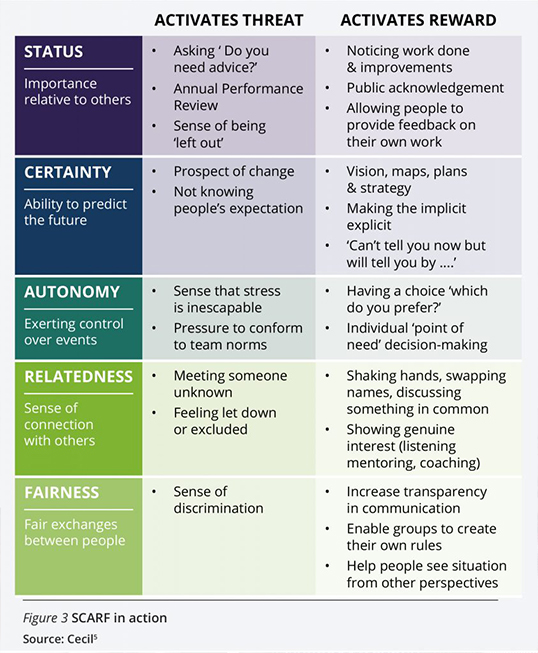On projects, we rarely work in isolation. There are many sources of social interaction and emotional triggers which affect the dynamic of the group, the individuals, and their work. David Rock, Director of the Neuroleadership Institute, developed the SCARF model to explain the five factors that the brain is always monitoring, which have a huge impact on how we behave.
- Status
The perception of being considered better or worse than others - Certainty
The ability to predict future events - Autonomy
The level of control we feel able to exert over our own lives - Relatedness
The sense of feeling safe with others - Fairness
The sense that we are being treated fairly with respect to others
When people sense a change in one of the SCARF factors, they feel threatened. This in turn creates a highly charged situation in which there is a clear tension in the air. Project managers require a basic knowledge of how to understand and respond to behaviour, so that when a teammate is getting defensive or a client is getting aggressive, they can understand why this is happening, and pinpoint & address the root of the issue.
Projects are ridden with changes. Change requests from clients, schedule changes among teammates, unexpected delays and setbacks. The SCARF model reminds us that our desire for Certainty (C) can result in a negative reaction from a teammate (or the entire team) at the prospect of change.
Project managers can include this knowledge into their project planning, and prioritize activities that minimize the degree of uncertainty. And the best way to do that is to communicate, communicate, communicate!
- Speak to the team about the vision for the future.
- Discuss what you do know about the future.
- Discuss what you don’t know about the future.
- Remind everyone that you don’t know what you don’t know, and that’s okay!
- Make time in your project plan to handle setbacks, deal with change, and change course if needed.
David Rock also explained how a change in any of the SCARF factors results in a threat response or a reward response. Here are some examples of how to use SCARF in organizational and project settings.

Source: The Fear-free Organization

 Bantter Blog
Bantter Blog